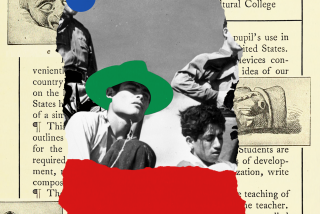World Events Leave Texts in Lurch : Publishing: Writers of history books and map-makers are outflanked by European, Mideast changes, leaving Orange County teachers to sort it all out.
The Berlin Wall is being dispersed around the world in souvenir-size chunks. But it still stands, immovable and permanent, in textbooks that are being thrown into lockers or lugged home in backpacks every day.
Germany became a unified nation today. But on the shade-pull maps being lowered in front of blackboards, East and West stand divided, and the Eastern Bloc still lives. So too does Kuwait, though Saddam Hussein is trying to redraw it as Province 19 of Iraq, to the outrage of much of the world.
History has done what history will do: It has kept happening, outpacing the textbook-writers and the map-makers and leaving teachers to explain one of its most profound lessons.
“It brings home the idea that nothing is fixed and concrete forever,” said Ken Stichter, principal of La Habra’s Sonora High School and the teacher of a senior history seminar. “This tells the students that history isn’t something that never changes.”
It may be some time before classroom materials catch up with history.
Editors and marketing managers at some of the largest publishers of textbooks say updated texts that include the events of the last year and reflect the passage of the Cold War are not yet widely available. More and more are being updated, but it may take up to two years before the process is complete.
And even when accounts of the sweeping changes of the last year--as well as the tension of the last two months in Kuwait--are written, printed and bound, that may not mean that their arrival in the classroom is imminent.
“It is always a concern when history changes,” said Gary Mieger, assistant superintendent for instructional services for the Fullerton Joint Union High School District. “But most school districts are not so wealthy they can just walk out and buy new textbooks because there is a unified Germany and no more Warsaw Pact.”
Some publishers took advantage of scheduled reprints to make changes and updates.
Richard Ravich, marketing manager at D.C. Heath & Co. in Lexington, Mass.--the nation’s sixth-largest publisher of school books--said its world history text had been updated by its author.
“He faxed in stuff, rush-rush stuff,” Ravich said. “There would be less analysis and more more-or-less factual presentation.
“Who knows what’s going to happen? Some people think they’ll end up with non-communist dictators in those countries. . . . The last parts of books tend to be more journalism than history. We still don’t know what’s going to happen. Look at the situation in the (Persian) Gulf. What if we had to go to press today with a history book? That’s the tough part there.”
Another publisher, the secondary school division of Macmillan/McGraw-Hill, produced a booklet update of current events and distributed it free to its customers.
“It was written in a newspaper style, with headlines covering all regions of the world and the events that took place,” said Carol Bloom, a senior editor based in Columbus, Ohio. “Others we had produced said things like, ‘On Page 27, Column 1, the sentence in the second paragraph should now say . . . ‘ It wasn’t very useful.”
Many teachers have turned to newspaper and magazine accounts and, increasingly, to videotapes of TV news.
At El Toro High School, where Bill Bailey teaches world history and advanced placement European history, students will receive new, updated books next year.
Of course, by then they could be outdated too.
Until then, one of the texts in use was printed in 1985, and another ends with accounts of the Cold War and the tense arms control negotiations of the 1970s.
“We have to patch in current events right now,” Bailey said. “Teachers seldom work out of the text to any degree of reliance. My final exam for the semester changes each year to reflect what has gone on in history, in an almost up-to-the-minute final.
“It was so easy when the East-West conflict was static for so many years. Now, the last few finals have changed from Latin America to the European situation.”
Textbooks are not alone in their new-found obsolescence. Outdated maps need to be replaced as well, often at considerable expense.
A standard classroom wall map of the world lists for $105 at Nystrom, a Chicago-based division of Herff Jones Inc., one of the largest producers of scholastic maps.
At Cal State Fullerton, where the geography department budgets up to $1,000 a year for maps, several professors have requested that the entire allotment be spent on European maps.
Bill Puzo, a Cal State professor of geography whose use of matching tests to point out students’ ignorance of geography has been much publicized, said: “People don’t care too much if it’s Upper Volta or Burkina Faso. That (name change) happened four or five years ago, and people either didn’t care or didn’t notice. But if it’s East Germany and West Germany, and lines around Berlin, people want to see it on the map.”
Map companies, like textbook companies, have been scrambling.
Anticipating demand for updated maps, Nystrom started making changes to reflect a unified Germany as early as July, meaning maps are now available for delivery.
“Oh, boy, have we got maps,” said Chuck Novosad, executive editor for social studies. “Obviously, there are quite a number of different maps in which Germany will appear. . . . We’re not accustomed to seeing changes in Europe as much as in Asia and Africa. Being Eurocentric, we think this is unusual, when in fact the same thing has been happening in Asia and Africa for many years.”
As events change, so does the interpretation of those that preceded them.
“Even recent textbooks place great emphasis on European nations and specific countries playing dominant roles,” said Stichter, the Sonora High principal. “And here we are in a crisis in the Mideast in which a small country is really dictating the diplomatic actions of major powers of the world.”
Ravich, the D.C. Heath marketing manager, recalled the backpedaling after Americans were taken hostage in Iran.
“After the shah of Iran was out, we needed to go out and get that adjusted,” Ravich said. “It was a whole new ballgame. The shah had been in most books described as a good friend to us, and Iran as an ally. All that flip-flopped. We went through quite a rewrite.”
But history keeps adding up while the books, and the school year, stay the same length.
“Really, there have been so many things that have happened in the 20th Century that it is very hard to teach in two or three grading periods,” said Bloom, the editor in the secondary division of Macmillan/McGraw-Hill. “It’s very difficult to get through all that material.”
In one effort to keep teachers from getting bogged down somewhere around the Battle of Britain, some new texts are condensing earlier chapters to emphasize more recent history.
Bloom said she hopes “that will help the teacher get through World War II. And it’s not so much World War II any more, now it’s Vietnam. If they don’t get past Vietnam . . .
“Well, we don’t need a generation that doesn’t know about Vietnam.”
More to Read
Sign up for our Book Club newsletter
Get the latest news, events and more from the Los Angeles Times Book Club, and help us get L.A. reading and talking.
You may occasionally receive promotional content from the Los Angeles Times.








